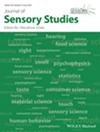This international study aimed to investigate cross-modal associations between parosmic sensations and visual information, as well as explore potential cross-cultural differences; 393 parosmia patients from Argentina, Germany, Japan, and the Philippines participated. The patients were provided with a 63-color chart encompassing diverse hues and a 20-shape chart containing polygonal and curved shapes. Their task was to choose one color and one shape that matched their parosmic sensations. Results indicated that patients generally associated their parosmic sensations with brownish or greenish colors, darker colors, and polygonal or cloud-like shapes. Significant cross-cultural differences were observed, with Germans tending to select darker colors and edged shapes, while Japanese preferred brighter colors and curved shapes. These differences appeared to be related to the intensity of parosmia, which was higher among Germans. The study suggests a cross-modal relationship between olfaction and vision, while also highlighting the influence of cultural factors on parosmia perception.
The findings of this study have practical implications for understanding and managing parosmia symptoms, particularly in multicultural settings. Healthcare professionals can use the cross-modal associations between olfactory sensations and visual information as a tool for assessment and diagnosis of parosmia patients. By considering the cultural background of patients, healthcare providers can better understand the nuances in their descriptions and interpretations of parosmic sensations. Additionally, the observed cross-cultural differences in color and shape associations can inform the development of standardized assessment tools that are sensitive to cultural variations. This knowledge can enhance communication between patients and healthcare professionals, leading to more accurate diagnosis, personalized treatment approaches, and improved patient outcomes. Furthermore, the study highlights the need for cultural sensitivity in odor-related research and the development of interventions for parosmia and other olfactory disorders.


